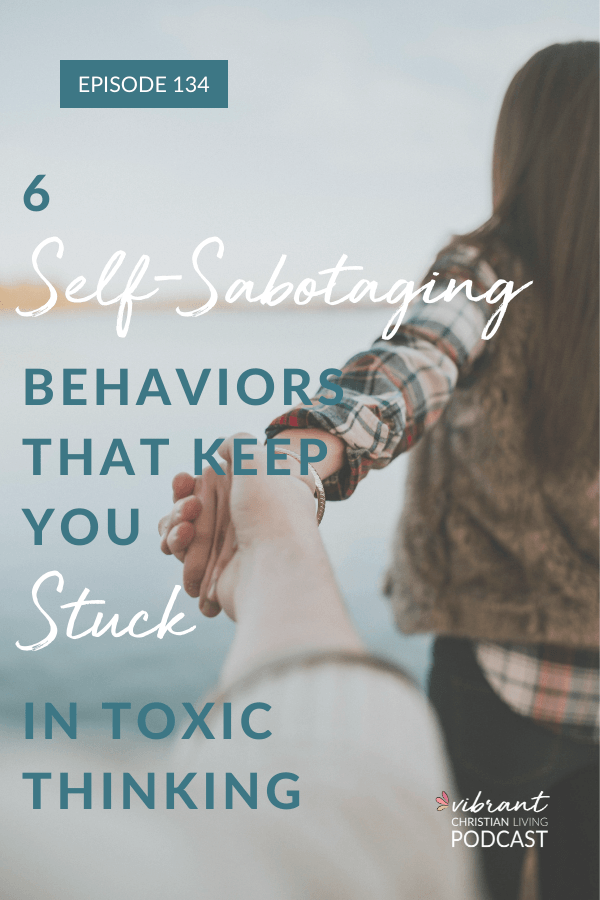The most frustrating part of renewing your mind is self-sabotage. Why would we work against ourselves to change our hearts and thoughts when we know what God wants for us?
Today we’re talking about what it means to self-sabotage, where self-sabotaging thought patterns come from, and why so many of us struggle with these self-sabotaging behaviors.
Plus I have a really fun acronym that I’ve created to help you overcome these self-sabotaging patterns so you can break free from them and find freedom.
WHAT YOU'LL LEARN:
- [2:09] Where self-sabotaging behaviors come from
- [5:05] The definition of self-sabotaging behaviors
- [7:54] Examples of self-sabotaging behaviors
- [13:38] The root cause of self-sabotage: a desire to take control
- [16:56] Self-sabotaging behaviors as a response to trauma
- [18:18] Trauma responses that impact our behavior
- [22:53] Breaking self-sabotaging behavior patterns with God’s help
- [24:24] Addressing and processing toxic thinking through brain priming
- [24:59] Managing self-sabotaging behaviors in the moment
[2:09] Where self-sabotaging behaviors come from
The first thing we need to understand about any behavior is that our actions come from our thoughts. Self-sabotaging behaviors, therefore, have a root thought that is causing the action. This is true in both brain science and in the Bible.
Matthew 15:18, “But the words you speak come from the heart – that’s what defiles you.”
Mark 7:20-23, “And then he added, “It is what comes from inside that defiles you. For from within, out of a person’s heart, come evil thoughts, sexual immorality, theft, murder, adulery, greed, wickedness, deceit, lustful desires, envy, slander, pride, and foolishness. All these vile things come from within; they are what defile you.”
James 4:1-2, What is causing the quarrels and fights among you? Don’t they come from the evil desires at war within you? You want what you don’t have, so you scheme and kill to get it. You are jealous of what others have, but you can’t get it, so you fight and wage war to take it away from them. Yet you don’t have what you want because you don’t ask God for it.
So, whatever outward behavior is happening, we have to go to that root thought to discover why it’s there. This is a critical part of brain science and of understanding how to renew our thoughts.
According to what the Bible says in Romans 8: 5-6, Those who are dominated by the sinful nature think about sinful things, but those who are controlled by the Holy Spirit think about things that please the Spirit. So letting your sinful nature control your mind leads to death. But letting the Spirit control your mind leads to life and peace.
Self-sabotaging behaviors come from our own thoughts and desires; something happening inside of us that isn’t in line with God. We need to do a bit of digging, therefore, to figure out what that is about.
So you might be wondering why we stay in these patterns. Why can’t we just change them, or why can’t we just fix them through willpower? If you’ve tried that (like I have!) you know that it’s not successful.
I tried for years to use willpower to change my thoughts and just ended up frustrated and spinning my wheels. Willpower isn’t our best weapon because we are trying to use logic to fight our subconscious mind. The brain is going to choose that subconscious mind over the logical mind, so we have to figure out the subconscious pattern that is running the show.
As we learn about the brain, we understand that the brain is always trying to protect us, keep us safe, and keep us alive. So we need to consider what the subconscious mind is trying to protect us from.
[5:05] The definition of self-sabotaging behaviors
When I talk about self-sabotaging behavior patterns, I’m not talking about a one-off thought. I’m talking about a toxic thought pattern that has been formed by our brain as a self-protective mechanism to compensate for a lack of safety, usually as related to three questions that our brain is answering to help us understand our identity in this world.
- Am I enough?
- Am I worthy?
- Am I loved?
How our brain has subconsciously answered those questions, usually by the time we are between 9-13 years old, affect our thought patterns.
A self-sabotaging pattern is toxic thinking, meaning that it doesn’t line up with God’s truth. So if God’s truth is our barometer, as we say in the Christian Mindset Makeover, then a toxic thought is not in line with God’s truth about who we are and our identity.
Toxic thought patterns have been formed by our brain to compensate for a lack of safety. Since our brain’s main goal is to keep us alive and safe, it can very quickly grow into these patterns of protecting ourselves. There can be a battle between the prefrontal cortex, or our logic brain, and the amygdala, which is giving off “danger” signals in the brain.
[7:54] Examples of self-sabotaging behaviors
So at their core, these thought patterns that produce self-sabotaging behaviors are trying to keep us safe. I’m sure you can think of some examples, and I wanted to share a few here as well.
First, overwhelm and anxiety are seen as “overthinking”.
Another example is our inability to live in the moment because of fear of the future. You may always be thinking about what you have to do next and where you need to go.
A third is the inability to live in the moment because of shame from the past. You may be ruminating on how you could have done things differently, and beating yourself up for that. That “over-analyzing” is toxic thinking as well.
Fourth, people-pleasing as seen through oversharing and overexplaining. As a side note, I began to see that present in so many people and so many relationships. I’m not saying that to condemn those people, but I’m saying it because I recognize that I have a tendency to do that myself. When I understood more about that self-sabotaging thought pattern, it became so understandable to me why I have so many friends who struggle with this as well and how it relates to some of the things they have gone through. It helps me to have compassion for them and for myself.
We are reacting as a result of how our brains have been conditioned in these situations, which is what is so fascinating. We don’t have to judge ourselves, but rather we should learn about and have compassion for the ways our brains have been created. When we know why our self-sabotaging behaviors exist, we can begin to unravel them and find a new way.
Number five is perfectionism, as seen through procrastination or workaholism. Something interesting about perfectionism is that this self-sabotaging behavior can be expressed in terms of opposites. You may choose to focus on something and work like a crazy person to avoid the pain. Or, you may procrastinate or feel like you can’t start because you don’t have the confidence to do so. Perfectionism is a huge self-sabotaging pattern of behavior, and I’ve talked about it in episode 126.
Lastly, there is comparison, seen through self-pity, jealousy, and lack of worth. We may think we don’t struggle with comparison, but then we experience emotions like, ‘Why God? Why would you allow her to have that and not me?’ Lack of worth comes into play when we think we aren’t as good as another person, or not as valuable to God.
When we really begin to tease out toxic thought patterns, those are detrimental to our ability to believe in God’s identity for us. We have a really hard time focusing on the truths of God when we have a diatribe going on in our heads telling us we aren’t worthy.
I know this is a lot to think about, but I want you to shake off any negative thoughts that are surfacing for you right now. We’re just looking at these patterns, and we aren’t going to be mad at ourselves about it.
There are a few other truths I want to share about these self-sabotaging patterns before we talk about how it relates to the brain. You may have a combination of these. There might be some evidences of overthinking as part of this anxiety, or you may have the inability to live in the moment because you’re afraid of what’s coming next. You might be overthinking your to-do list, what’s going to happen next, and even the smallest decisions. All of that may be coming up.
You may have people-pleasing as a way to compensate for your shame of the past. That inability to live in the moment may be related to you trying to fix things, make peace, or make up for a perceived “mistake”. It’s that perception of something that needed to be changed. So these combinations can feed off each other and we each have different ways that these patterns can be true and expressed.
Perfectionism is a great example. We can have five different women who all struggle with perfectionism and they express it in completely different ways based on their motivations, what makes them feel safe, and how they choose to cope.
So that “training” in our minds can come from past experiences such as what was modeled in our family, our personal makeup, and our motivation. Things like the Enneagram, that tell us what motivates us, can even be expressed in how we think about these self-sabotaging thought patterns.
[13:38] The root cause of self-sabotage: a desire to take control
The key thing that I want you to understand about all of these toxic thinking patterns is that they usually have a similar root cause: a desire to take control of something that feels out of control. As we mentioned before, self-sabotaging patterns are often based around a trigger of not feeling safe. So what we’re trying to do with our behaviors then is to take back that control. That control makes us feel safe. It’s a self-protective mechanism, and the brain is subconsciously trying to protect us from real or perceived pain.
If we have told our brain that the threat is there, it’s as real as if it really is there. It doesn’t have to be true for us to create these subconscious patterns, which is why it’s so important to really get a handle on the thoughts we have throughout the day. If our thoughts are spinning and building upon themselves, we are going to perceive the world and react based on that lens.
Self-sabotage usually involves a situation where our safety is threatened, and our brain compensates by finding a way to overcome it. It’s that fight or flight part of our mind that is being triggered (the amygdala). If the amygdala is triggered over and over, it can become almost overactive. If we have told our brain that this is a big deal, a threat, or a problem, it’s going to believe that it is and fire more. So you can see, it really builds on itself.
[16:56] Self-sabotaging behaviors as a response to trauma
The thought patterns behind our self-sabotaging behaviors are usually formed in response to trauma.
Let’s give the example of a physical trauma: breaking your arm in a car accident. Your arm can heal. If it’s not set correctly, though, it could heal in an odd-looking and potentially painful way. Yet even if you do set it correctly in a cast and it all comes off great, there may always be some weakness in that bone. There is still trauma there.
So when a trauma has happened, we may have healed from it. We may have forgiven that person. We have gone to God about it. Either way, there is a compensation that happens in the mind to avoid that pain and keep us safe. Our body creates almost like a “limp”. We may heal from the trauma but those parts of the body are weaker than others because of the trauma. In the same way, our mind recognizes the past trauma and is firing as a way to protect us from future trauma in that area.
[18:18] Trauma responses that impact our behavior
There are six main trauma responses, but we’re going to focus on four of them here.
1. Fight
When we fight something, we give an aggressive response. We may yell, or fight back. We might even yell at ourselves and say, “What’s wrong with you? Get over it!” We think we’re protecting ourselves, but we are really sabotaging ourselves or sabotaging God’s ability to heal us through it.
2. Flight
Flight may involve us running away from a problem. For example, the self-sabotaging behavior of overworking as part of perfectionism. This keeps us trapped in something that numbs us, and we can escape from what is going on. Addiction can often be a flight strategy as well. As a former workaholic, I used to feel like I had to be busy all the time, and the more that God has healed my mind, the easier it has been for me to not have to be so busy. I was better able to just stop, find stillness, and rest.
If you’re feeling like it’s really hard to even take time for self-care, relaxation, and stillness, it could be that flight instinct or thought pattern.
3. Freeze
With the freeze response, we get stuck in overthinking. We get stuck in the what-ifs, and we don’t take action because we’re afraid to move forward or backward.
4. Fawn
Fawn is the people-pleasing response. You're going to do whatever it takes, even if it’s unhealthy or excessive, to do whatever that person needs to make them happy or to make yourself appear good in front of others. There is an underlying thought pattern that when you do those things, you feel loved and worthy. Appeasing others makes you feel good about yourself.
So you can see how these unhealthy trauma responses can develop into some of these self-sabotaging behaviors that we talked about above. These patterns are to be expected because our brain is programmed to keep us alive, and to compensate for areas that trigger the amygdala or make us feel unsafe.
A pearl is created by a tiny grain of sand that gets inside of an oyster and irritates the delicate skin so much that the oyster begins to put this substance around the grain of sand to protect itself from it. It keeps doing that over and over again, and that is how a pearl is created.
That’s what we do with these compensating behaviors. It makes sense we have them because our brains are programmed to compensate in that way, and we live in a fallen, stressful world full of opportunities for hurt. The good news is that we get to decide how to handle what happens to us, and how we’re going to respond to the traumas that come our way.
[22:53] Breaking self-sabotaging behavior patterns with God’s help
We’re not always in control of what happens, but we are always in charge of how we respond to it. If we begin to see these self-sabotaging behaviors and we can be aware of our toxic thinking creating these “limps” inside of us, we have the ability and the responsibility to decide, “I’m going to take care of this with God’s help.”
There are three things we can do first to manage them. We do our part to notice them with this loving compassion, then we process them as needed. Below, you’ll find an acronym to help you work through them, because we aren’t just going to ignore them.
We don’t want to just say they’re bad, they’re wrong, don’t do that anymore. That’s a totally normal response, and I tried it for most of my life, but it will not solve it. It’s just going to keep us stuck in that pattern.
We’re going to process them as they come up, and then we’re going to surrender that healing to God. We’re going to let Him bring the healing. We’re going to take the steps, but God has to be the one to bring the restoration.
It’s not in us powering forward and doing all the right steps – it’s doing our part and then waiting in surrender and trust for Him to bring the supernatural healing that only He can. We can’t bring supernatural change to ourselves.
[24:24] Addressing and processing toxic thinking through brain priming
The first way we can process self-sabotaging thought patterns is through brain priming. In the Christian Mindset Makeover, we use brain priming to access those core broken soundtracks that are causing some of these patterns. This is the deep work of pruning, and creating new soundtracks. What we’re talking about now is how to manage the patterns in the moment. If these self-sabotaging behaviors creep up, brain priming is so effective.
[24:59] Managing self-sabotaging behaviors in the moment
I’m going to reserve an in-depth discussion on how to apply it to self-sabotaging thoughts for the Christian Mindset Makeover, so let’s talk about how to use, in the moment, a tool to help us reinforce the deeper work we would do through brain priming with a healthy response to a self-sabotaging pattern.
I like to use an acronym: TACOS.
T – Notice TRIGGERS for those patterns
Think about what is causing your toxic thoughts that are leading to self-sabotaging behaviors.
A – ACKNOWLEDGE the sign that you’re stuck in that pattern
Be gentle with yourself, and see the pattern for what it is. There is no need to be mad at yourself about it, but do notice it. You can also name it, like reminding yourself that this is perfectionism; this is comparison; this is me living in fear of the future.
C – CONSIDER what is going on and how you can turn off the amygdala and turn on the prefrontal cortex
You can say, “all right, I see what my amygdala is trying to do here. It’s trying to protect me, and that makes sense given the situation. I’m going to analyze it, think about it from a logical standpoint, and think through it.”
O – ORIENT your mind differently using acknowledge / discern / decide, which is a process we teach in the course as well
You’re going to acknowledge the pattern by saying something like, it makes sense that I am sitting here unable to enjoy this beautiful day at the beach because I’m worried about this huge bill I have to pay. When you discern, you think about what is true and untrue about the situation. For example, it is true that I have a bill that I need to pay. It’s also true that God always provides for me. He has shown over and over that He is going to show up, and He is never going to leave me.
So your decision would be, I am going to trust Him. It’s a scary decision, but I’m choosing to believe that He is going to provide.
S – SURRENDER to ongoing healing
You can commit to God to call on Him to help during the times self-sabotaging behaviors and thought patterns surface.
It’s saying, I can let go of that pattern in this moment because I recognize that is what’s going on. I acknowledge the signs, I understand why the amygdala is being triggered, and then I create a different decision for how I’m going to respond in the moment using ADD (Acknowledge / Discern / Decide).
Answer this question and let’s connect on Instagram
I would love for you to reach out to me on Instagram and let me know your answer to this question: What are some of the self-sabotaging behaviors that you struggle with the most?
Then I want you to ask yourself, how can I see these responses to self-sabotaging thought patterns? How can I see them as trauma responses?
It doesn’t have to be a really big trauma. It can be something that has been happening in your life for a while, or maybe it happened a long time ago. Anything that was troubling, difficult to go through, or a disruption that caused you to have to think differently than maybe what God wanted you to think in that moment (which, hello, is most of life – right?).
So I’d love to hear from you on Instagram, and you can let me know about how your self-sabotaging behaviors might be rooted in a trauma response.
OTHER PODCAST EPISODES ON OVERCOMING SELF-SABOTAGE:
- Ep 59: Living in God’s Love When You’ve Been Hurt with Sarah Mae
- Ep 62: Mindset Matters: Breaking the What If Worry Cycle
- Ep 127: Mindset Coaching: “How can I stop thinking I’m not good enough?” with Heidi
- Ep 129: How to Identify Toxic Thinking Patterns and Break Free from Negative Thoughts
- Ep 133: Brain Priming: #1 Brain Hack to Renew Your Mind and Overcome Negative Thoughts
Please Subscribe to the Podcast + Leave a Podcast Review
- First, please subscribe to the Vibrant Christian Living Podcast in your favorite podcast player (subscribe here on Apple Podcasts or follow on Spotify),
- leave a review (5 stars if you loved it) and comment HERE.
FREE WORKSHOP: Learn How to Transform Your Thoughts to Transform Your Life
Do you find it hard to let go of worry? Struggle with feeling you’re never enough?
Or maybe you’re frustrated because you can’t make the changes you want in your life (lose the weight, start new habits or grow in a certain area)?
Both brain science AND scripture show that every action we take starts first with a thought. If we change our thoughts, we can change our results.
That’s why I want to give you the inside scoop on the most effective ways to change our thoughts at this FREE WORKSHOP!
Sign up now at VibrantChristianLiving.com/mind

At this FREE WORKSHOP you’ll learn:
- Why it makes sense you’re stuck in toxic thought patterns
- The truth behind 3 popular myths on how to overcome negative thoughts
- A simple 3-step strategy to manage negative thoughts in-the-moment (this powerful tool alone is worth coming!)
Plus you’ll get an inside look at the Christian Mindset Makeover™–the only course that equips Christian women with powerful brain-science + biblically based tools to break free from negative thoughts—in only 9 weeks!
Go now to VibrantChristianLiving.com/mind right now to sign up for this amazing FREE WORKSHOP to learn how to transform your thoughts to transform your life.


